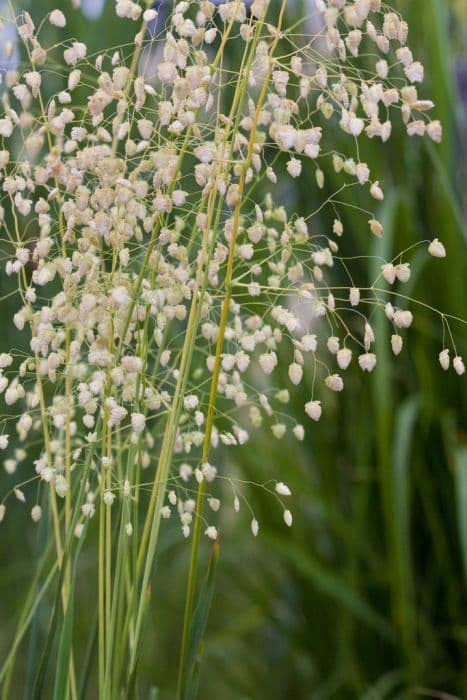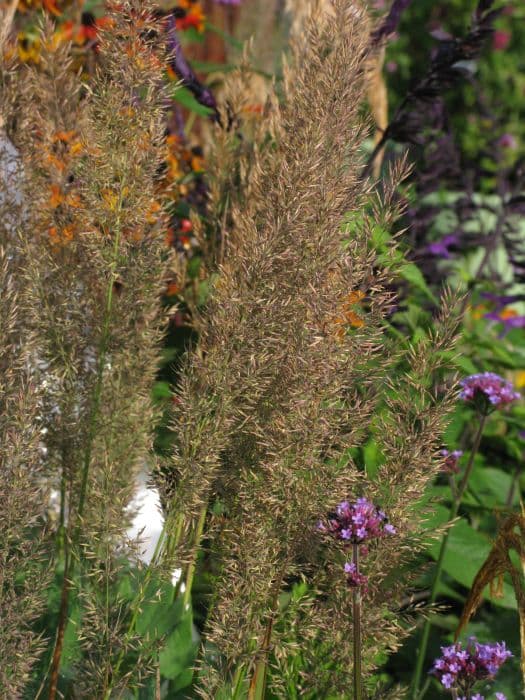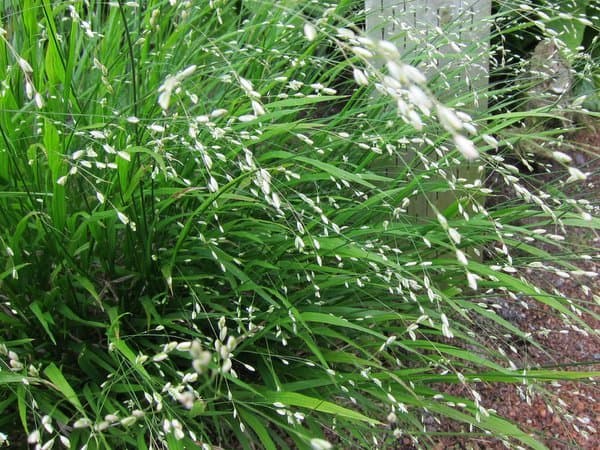Weeping Lovegrass Eragrostis curvula

ABOUT
The plant known as weeping lovegrass is a perennial grass that is recognized for its clumping growth habit. It has a distinctive arching form with long, narrow leaves that are a greyish-green color. These leaves tend to droop, giving the plant a fountain-like appearance that contributes to its common name. Another notable feature of weeping lovegrass is its seed heads, which emerge as delicate, airy panicles. These seed heads appear purplish to golden-brown, creating an attractive contrast against the foliage. They sway gracefully in the wind and can add a soft, textured look to gardens or landscapes. The plant's overall appearance is fine-textured, and it commonly exudes an elegant, wispy aesthetic. Weeping lovegrass thrives in sunny environments and is often utilized for its erosion control capabilities and as a forage plant in pasture settings, where its appearance can vary based on growing conditions and maintenance.
About this plant
 Names
NamesFamily
Poaceae.
Synonyms
Weeping Lovegrass, African Lovegrass, Boer Lovegrass, Curved Lovegrass, Curly Lovegrass.
Common names
Eragrostis curvula var. conferta, Eragrostis lehmanniana, Eragrostis usambarensis, Poa curvula.
 Toxicity
ToxicityTo humans
Weeping lovegrass (Eragrostis curvula) is not considered toxic to humans. There is limited information suggesting that it poses any significant health risks upon ingestion. However, as with many plants, individual allergies or sensitivities may still exist. If a person were to have a rare reaction, it could involve gastrointestinal discomfort or other mild symptoms. Generally, however, weeping lovegrass is not associated with severe toxicity or serious consequences for humans.
To pets
Weeping lovegrass (Eragrostis curvula) is not known to be toxic to pets. It does not contain known toxins that would cause poisoning in animals such as dogs, cats, or horses. Pets that ingest this grass may experience the same types of reactions as humans, if any, such as mild gastrointestinal upset. But generally, it is considered safe and is not associated with serious health risks for pets.
 Characteristics
CharacteristicsLife cycle
Perennials
Foliage type
Deciduous
Color of leaves
Green
Flower color
Varies
Height
2-3 feet (60-90 cm)
Spread
2 feet (60 cm)
Plant type
Herb
Hardiness zones
8
Native area
Africa
Benefits
 General Benefits
General Benefits- Drought tolerance - Eragrostis curvula, commonly known as weeping lovegrass, is highly resistant to drought, making it suitable for arid climates.
- Erosion control - Its extensive root system stabilizes soil and helps prevent erosion, particularly on slopes and in areas of water runoff.
- Livestock forage - Weeping lovegrass is used as a forage plant for livestock due to its palatability and nutritional content.
- Low maintenance - This species requires minimal care once established, needing little water or fertilization.
- Soil improvement - It can improve soil structure and fertility through its root system and by adding organic matter as it decomposes.
- Quick cover - Weeping lovegrass establishes quickly, providing rapid ground cover for restoration and reclamation projects.
- Wildlife habitat - It provides shelter and food for various wildlife species, including birds and small mammals.
- Landscape aesthetics - With its fine texture and weeping growth pattern, it is used in landscaping for aesthetic appeal.
- Soil fertility indication - Presence of weeping lovegrass can be an indicator of low soil fertility, guiding land management practices.
- Pasture improvement - When used in a mixed planting, it can contribute to the overall productivity and health of pasture systems.
 Medical Properties
Medical Properties- This plant is not used for medical purposes.
 Air-purifying Qualities
Air-purifying QualitiesThis plant is not specifically known for air purifying qualities.
 Other Uses
Other Uses- Eragrostis curvula, commonly known as weeping lovegrass, can be used for soil erosion control as its dense roots bind the soil effectively.
- In landscaping, weeping lovegrass adds a fine-textured element to gardens and is used to create natural-looking landscapes or wild meadows.
- This plant acts as a forage and hay source for livestock, providing a high-quality feed when young and managed properly.
- Weeping lovegrass can be incorporated into thatched roofs for traditional or rustic styled buildings due to its durable and long strands.
- Eragrostis curvula may be used in crafting paper or bio-fiber products, taking advantage of its fibrous material for an alternative to wood pulp.
- In agricultural practices, weeping lovegrass is utilized as a cover crop to suppress weeds and maintain soil fertility.
- The plant is sometimes used as a bioindicator to assess the presence of heavy metals in contaminated soils as it can accumulate certain toxins in its tissues.
- Weeping lovegrass can serve as nesting material for birds, providing a natural and safe environment for bird eggs and chicks.
- Dried weeping lovegrass can be woven into mats, baskets, and other artisan crafts, showcasing its flexibility and natural beauty in decorative items.
- During restoration projects, Eragrostis curvula helps to stabilize the soil, promoting the reestablishment of native plants and preventing invasive species from taking over.
Interesting Facts
 Feng Shui
Feng ShuiThe Weeping Lovegrass is not used in Feng Shui practice.
 Zodiac Sign Compitability
Zodiac Sign CompitabilityThe Weeping Lovegrass is not used in astrology practice.
 Plant Symbolism
Plant Symbolism- Resilience: Eragrostis curvula, commonly known as weeping lovegrass, often symbolizes strength and the ability to withstand challenging conditions due to its drought-tolerant nature.
- Adaptability: As a plant that can thrive in poor soils, weeping lovegrass represents the ability to adapt to and flourish in diverse and difficult environments.
- Abundance: With its prolific seed production and quick spreading habit, weeping lovegrass can signify abundance and fertility.
- Persistence: The tenacious growth habit of weeping lovegrass reflects persistence and the determination to persevere.
- Grace: Its fine leaves that sway gracefully in the wind give weeping lovegrass a symbolic meaning of elegance and beauty.
 Water
WaterWeeping lovegrass prefers infrequent but deep watering, encouraging the development of a strong root system. Aim to water with about 1 inch of water every week during the active growing season, adjusting for rainfall, as the soil should be allowed to dry out between waterings. During periods of drought or extreme heat, you may need to water twice a week, ensuring each time that the water penetrates deeply into the soil, reaching the root zone. Reduce watering in the winter when the plant is dormant, providing just enough moisture to prevent the soil from becoming completely dry.
 Light
LightWeeping lovegrass thrives in full sun conditions. It requires a minimum of 6 hours of direct sunlight daily to maintain vigorous growth and optimum health. This grass prefers a spot in the garden or landscape that is unobstructed by trees or buildings to ensure it receives ample sunlight throughout the day.
 Temperature
TemperatureWeeping lovegrass is best suited to warm climate conditions, flourishing in temperatures that range between 60 and 80 degrees Fahrenheit. It can tolerate a minimum temperature of around 20 degrees Fahrenheit but will suffer damage if exposed to temperatures below freezing for extended periods. This resilient grass does well in the heat and can survive in temperatures exceeding 90 degrees Fahrenheit, making it ideal for warmer regions.
 Pruning
PruningPruning weeping lovegrass is essential to maintain its tidy appearance and promote new growth. Trim back the grass in late winter or early spring before new shoots appear, removing old, dead foliage and shaping the plant. Prune annually to keep the grass looking its best and to prevent it from becoming too dense, which can lead to issues with airflow and disease.
 Cleaning
CleaningAs needed
 Soil
SoilWeeping Lovegrass prefers well-drained soil with a pH range of 5.5 to 7.5. A good soil mix can be made with loamy garden soil, sand, and compost in equal parts for improved structure and nutrition.
 Repotting
RepottingWeeping Lovegrass typically doesn't require frequent repotting. Repot it every two to three years or when the plant outgrows its current container, ensuring minimal root disturbance.
 Humidity & Misting
Humidity & MistingWeeping Lovegrass is tolerant of a wide range of humidity levels and thrives best with average atmospheric humidity, without the need for specific adjustments.
 Suitable locations
Suitable locationsIndoor
Place Weeping Lovegrass in bright light and maintain regular watering.
Outdoor
Plant Weeping Lovegrass in full sun and well-drained soil.
Hardiness zone
7-11 USDA
 Life cycle
Life cycleEragrostis curvula, commonly known as weeping lovegrass, begins its life cycle with seed germination, which requires appropriate temperatures and moisture conditions. After germination, seedlings establish their root systems and grow into tufted clumps with narrow, rolled leaves. In its vegetative stage, weeping lovegrass focuses on leaf and root growth, rapidly forming dense cover. Flowering occurs in the warmer months, with the plant producing tall, slender, and nodding inflorescences which bear tiny, clustered spikelets. Following pollination, the plant develops seeds that mature, dry, and are dispersed by wind or mechanical means. The plant is perennial, with individual plants potentially surviving several years, but it often reestablishes through self-seeding annually.
 Propogation
PropogationPropogation time
Spring to Summer
Weeping lovegrass, scientifically known as Eragrostis curvula, is commonly propagated through seeding. The most favored time to sow the seeds of weeping lovegrass is during the spring, when soil temperatures have consistently reached about 60°F (15.6°C). To propagate, distribute the small seeds evenly across a well-prepared seedbed that is free of weeds and has been finely raked to a smooth surface. Using a broadcast spreader or by hand, seeds should be sown shallowly at a depth of about 1/8 inch (about 3 mm), as they require light to germinate effectively. After sowing, seeds may be lightly covered with soil or pressed into the soil using a roller to ensure good seed-to-soil contact, which is crucial for germination. Keep the soil moist but not waterlogged, as excessive moisture can lead to fungal diseases and poor seed germination. Under optimal conditions, germination typically occurs within 10 to 14 days.









